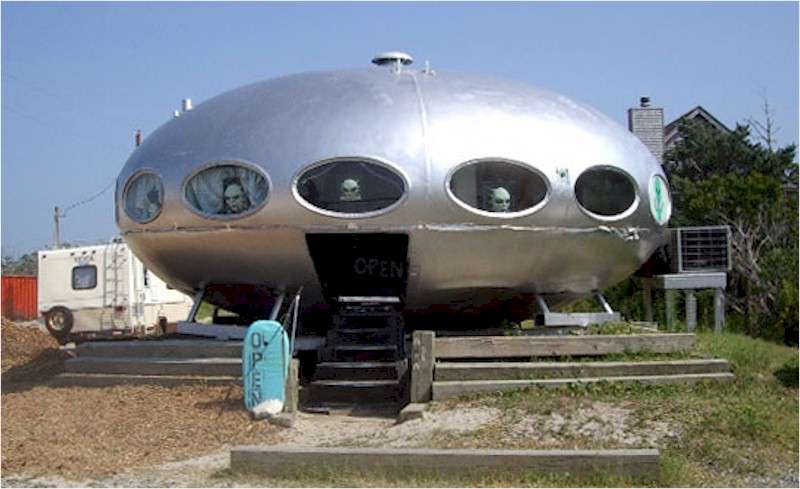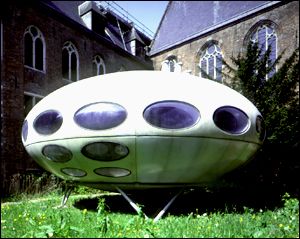Plastic Is So Passé Now
The Future Has Passed...The future will be better tomorrow. - Dan Quayle Future: that period of time in which our affairs prosper, our friends are true and our happiness is assured. - Ambrose Bierce I've seen the future and it's much like the present only longer. - Dan Quisenberry
Futuro House Hatteras Island North Carolina - 1968 by Finnish architect Matti Suuronen Only 20 of these "ski cabins" or vacation homes were built. Each could accommodate 8 people in modern comfort. One is beached on Hatteras Island, North Carolina; years ago it was operating as an ice cream stand, now it is only occasionally open; the owners sell retro "space age" items. Finnish architect Matti Suuronen designed this UFO shaped dwelling in 1968, initially for use as a ski-cabin or holiday home. The idea behind the design reflects the optimism of the 1960s. At the time, people believed technology could solve all problems for the human race. The ideal was of a new era, a space-age, where everybody would have more leisure time to spend on holidays away from home. The Futuro house was completely furnished and could accommodate 8 people. It was constructed entirely out of reinforced plastic, a new, light and inexpensive material back then. The plan was to mass-produce it, so it would be cheap enough to house all people around the earth. Because it was so lightweight, it was easily transportable by helicopter. Mobile living was the new possibility for the future! People could take their moveable home with them, to wherever they went, and live like modern nomads. Unfortunately the 1973 oil crisis spoiled all these plans. Prices of plastic raised production costs too high to be profitable as its aesthetics were not above those of a conventional house. Thus, only 20 were ever built. Source: recentpast.org, home.wanadoo.nl photo credit Sally Greene
Matti Suuroonen: Futuro House
1968 inv. no. 28218 The 1960s saw new belief in technological progress. New materials were finding their way into national defence and individual households. Matti Suuroonen designed the Futuro in Finland in 1968. It was a UFO in polyester, an ideal design: beginning with the Futuro, living would forevermore be mobile. The Futuro was light, moveable and suitable for use as an office or holiday home. It is completely furnished for eight people. The Centraal Museum collection here includes a prototype of a mass-production product that was never mass-produced. In total, only 20 Futuros were ever completed. Source: centraalmuseum.nl
Click to Begin Source: skyltmalarn.se Did you notice? None of the kids was pierced or tattooed! What kind of future is that?
Finding Yesteryear's House of Tomorrowby Phil Patton Richard Pisani caught his first glimpse of a Futuro house beside a lake in Illinois in the early 1980s, outlined against the setting sun. "I was just out cruising and there it was in some subdivision," Pisani said, "like a prop from a sci-fi movie." For the next 15 years, he saw the house often and could not get its flying-saucer form out of his mind. Finally, in 1997, he bought it, paying a tenth of the $20,000 asking price. Using a flatbed truck, he moved it to the yard behind his house in nearby Danvers, and turned it into a media room. In the process, he joined a growing network of Futuro owners and fans who have dedicated themselves to celebrating and preserving this strange prefabricated house, which looks like it came not just from an earlier decade, but even from another planet. By 2004, in fact, he had become one of the world's foremost authorities on the fate of the Futuros, numbering perhaps as many as 100, that were built between 1968 and 1978. The circular house, 11 feet, or 3 metres, high and 26 feet across, was designed by Matti Suuronen, a Finnish architect, in 1968. A hatch door in its lower half opened down to reveal steps, like the door of a small airplane, and led into a room outfitted with 6 plastic bed-chair combinations and a central fireplace slab, as well as a kitchenette and a bathroom. Photographs from the time make the house look like a place where the Teletubbies might live. Mika Taanila, a Finnish filmmaker who helped start the Futuro revival with his 1998 documentary Futuro: A New Stance for Tomorrow, said he became interested in the houses because they seemed to represent the mood of the late 1960s so precisely. They reflected the era's "economic boom and optimism about the future," he said in a telephone interview from Finland. "Suuronen could not have come up with the idea 15 years earlier or 10 years later." Part of that optimism was about the potential for plastics and prefabrication to radically lower the cost of housing, in the revolutionary spirit of 1968. The Futuro, which was made of polyester plastic and fiberglass and which sold in the United States for $12,000 to $14,000, was one of many experimental plastic houses at the time. It came in 16 pieces that could easily be moved by truck or helicopter and set up in a couple of days. But the house has captured contemporary imaginations more for its look than for its idealistic history. It embodies a strain of modernism that can be seen either as visionary or kitschy, but that certainly stands apart from the sober elegance of much mid-century modern design. Owners of surviving Futuros typically decorate them with lava lamps, plastic chairs and 1970s television sets shaped like spacesuit helmets. "The persistence of this sort of vision of the future is amazing," said Christopher Mount, the director of exhibitions and public programs at the Parsons School of Design, who has curated several shows on Scandinavian design. "This was a vision that included Panton furniture and 2001: A Space Odyssey, orange plastic and silver jump suits," Mount said. "You could look at the Futuro house as a giant Panton chair." Pisani, who sells and installs home gutters, became fascinated with Futuros, and began researching their history after he bought his own. "It made me feel good to know that wasn't just some oddball piece of junk but part of a serious attempt at mass housing," he said. Last year, he set up a website, www.futuro-house.net, to find and document all the surviving Futuros in the world. He estimates that there are about 60, in various states of repair and disrepair. The list of confirmed and suspected Futuro locations on Pisani's website has grown as word about the site has spread. The country with the most Futuros seems to be New Zealand, with about a dozen. One, in Pensacola, Florida, survived Hurricane Ivan "because of the aerodynamics of flying saucers," Pisani said. Pisani's own Futuro has become something of a tourist destination. In the summer, leaves hide it from passers-by on nearby streets, but in the winter, thanks to increasing awareness of the Futuro, visitors often seek out his home at inconvenient times. "Last Christmas," he recalled, "some crazy guy came roaring up my driveway - at 2:30 in the morning." Suuronen, who now lives in retirement outside Helsinki, built the first Futuro as a vacation house for a friend. He never planned on mass production, but the attention the house attracted led the Finnish company Polykem to market the design in 1968. Leonard Fruchter, a Philadelphia developer, bought the American licensing rights and began making them in the United States the next year. In Europe, the Swedish Air Force bought several Futuros to house technicians at remote radar stations, and the Soviet government contracted to purchase several more to help meet the needs of the planned 1980 Olympics. But the oil shocks of 1973, which sent the price of plastic skyrocketing, along with changing fashions, helped put a stop to the growth of the Futuro's market. Polykem stopped making the houses in 1978. Then, in the early 1990s, the Futuro began its comeback, when European artists started using the houses in installations. In 1998, Taanila brought out his film, and later he and Marko Home wrote a coffee table book, Futuro: Tomorrow's House from Yesterday, published by Desura in 2002. "I still get quite a lot of e-mail, mostly from people who would like to buy one," said Taanila. "Do I know any that are for sale? Some wonder if production might be restarted." Suuronen, now in his early 70s, could not be reached for this article, but Taanila says that Suuronen, whom he speaks to from time to time, is also happy. "He is very flattered and surprised because this is a totally new generation interested in his idea," Taanila said. "But he is also puzzled what to do with all this newborn interest." Phil Patton is a reporter for the The New York Times Source: iht.com Herald Tribune 29 July 2005
For more on the unusual: events, abilities, means of self-expression, houses, conditions, people, luck, narrow escapes, resemblances, facts, diversions, heroism and more - click
the "Up" button below to take you to the "Retreats" page. Clicking "Up" from there will take you to the Index page for this Odds and Oddities section where you'll find all
sorts of things. |
 Animals
Animals Animation
Animation Art of Playing Cards
Art of Playing Cards Drugs
Drugs Education
Education Environment
Environment Flying
Flying History
History Humour
Humour Immigration
Immigration Info/Tech
Info/Tech Intellectual/Entertaining
Intellectual/Entertaining Lifestyles
Lifestyles Men
Men Money/Politics/Law
Money/Politics/Law New Jersey
New Jersey Odds and Oddities
Odds and Oddities Older & Under
Older & Under Photography
Photography Prisons
Prisons Relationships
Relationships Science
Science Social/Cultural
Social/Cultural Terrorism
Terrorism Wellington
Wellington Working
Working Zero Return Investment
Zero Return Investment
